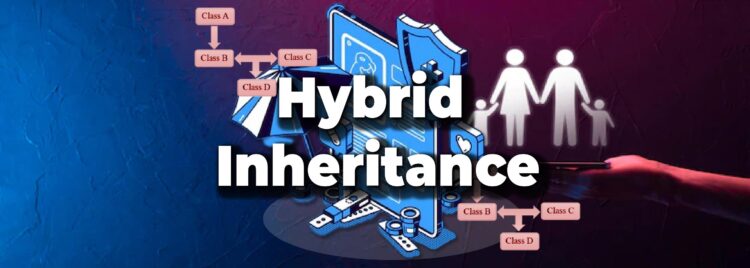Table of Contents
ToggleIntroduction:
Are you looking to learn more about Hybrid Inheritance in Object Oriented Programming? This blog is here to help explain just that! Hybrid Inheritance is the combination of multiple inheritance types within a program.
It consists of using subclasses and classes to achieve results. In Java, Hybrid Inheritance can be implemented through multiple inheritances using an interface.
So, what exactly is Multiple Inheritance? Multiple Inheritance is when a class derives features from two or more base classes. It’s important to note that Java does not support multiple inheritances, but interfaces can be used as a workaround for it.
For example, a subclass can extend one superclass and implement multiple interfaces which provide its own set of methods and properties.
Now onto Multilevel Inheritance. Multilevel inheritance consists of extending a class from an already existing subclass. This type of inheritance allows for code reuse and access to members from the parent class in their extended class.
Furthermore, this type of inheritance is also more efficient due to its ability to break down bigger pieces of code into smaller chunks that make it easier to manage and debug if any issues arise.
Finally, we have Hybrid Inheritance which combines both multiple inheritances well as a multi-level inheritance in order to form a complex structure within the program.
This structure allows the programmer to access feat features in both forms simultaneously while allowing them to break easily break up large pieces of code into organized sections
In conclusion, hybrid inheritance is an advanced form of object-oriented programming that can be used to combine the features and structures of both multiple and multilevel inheritances into one cohesive unit for greater efficiency when coding projects for larger applications or software solutions.
Types of Hybrid Inheritance

Hybrid Inheritance is the combination of two or more types of inheritance, such as single and multiple inheritances It enables programmers to combine the features of different kinds of inheritance to create reusable code that is easy to modify and debug.
The various types of hybrid inheritance include multilevel, multiple, hierarchical, and interface implementations in Java. Multilevel hybrid inheritance is when a class is derived from one superclass which in turn is derived from another class, creating a chain.
Multiple hybrid inheritances are when a class inherits from more than one superclass, usually for the purpose of reusing code between them.
Hierarchical hybrid inheritance occurs when there are multiple subclasses extending the same base class to get the same properties and methods. And with interface implementation in Java, multiple classes can implement the same interface and pass along some methods and data fields that would otherwise have to be written multiple times.
Using hybrid inheritance has several benefits over single or even double inheritance it increases software components’ reusability, enables faster code development by applying existing code to new circumstances, reduces coding errors by preventing duplication of code across different classes, and creates better-defined relationships between classes in object-oriented programming (OOPs).
Furthermore, all popular programming languages like C++, Python, and Java support several syntaxes for different types of hybrid constructs.
To demonstrate this concept further here’s an example using Python:
// Base Class
class A:
def __init__(self):
self.name = “A” // Derived Class 1
class B(A): def __init__(self):
self.age = 20
Read more about: Multi Inheritance in Java
Advantages and Disadvantages of Hybrid Inheritance

Hybrid inheritance refers to a combination of multiple and single inheritance structures in order to achieve desired results. It allows for greater flexibility and complexity in coding, but with that comes to some drawbacks as well. In this blog, we’ll discuss the advantages and disadvantages of this type of inheritance.
Firstly, let’s look at the types of hybrid inheritances available. There are several types out there, including multilevel, hierarchical, and multiple inheritances using interfaces. All these types involve combining different levels of inheritance within one program or database.
One advantage of using hybrid inheritance is that it can result in less complex code overall. With the ability to combine multiple inheritance structures, developers can make more efficient use of their code instead of writing separate functions for each level or type of inheritance.
Additionally, hybrid inheritance can also help avoid problems related to incompatibilities between languages and platforms when dealing with different levels or types of data storage.
Of course, there are also some pitfalls associated with hybrid inheritances as well. Firstly, using too many levels or types in a single program can be confusing for developers who may not be familiar with such complicated structures.
Additionally, problems may arise when attempting to implement code using hybrid inheritances in certain programming languages, which could lead to unintended consequences such as memory leaks or problems running the program on certain platforms.
It is thus important that developers take extra care when implementing hybrid inheritances in order to minimize potential issues that could arise from the incorrect implementation or the use of incompatible languages and platforms.
However, if done correctly, hybrid inheritances can offer many benefits including increased flexibility and efficiency when designing applications as well as improved code readability and maintainability over time.
Programming Languages Supporting Hybrid Inheritance

Hybrid inheritance is an advanced concept of Object Oriented Programming (OOP). It combines all the features of multiple inheritances, making it one of the most complex inheritance patterns available.
Unlike single inheritance, where a class can only inherit from a single superclass, hybrid inheritance allows a class to inherit from multiple superclasses.
The process of creating classes with hybrid inheritance requires a lot of expertise and knowledge of the syntax associated with multiple inheritances. This is because all of the different parent classes need to be specified within the class definition itself.
The compiling process for languages supporting hybrid inheritance is also relatively complex since it involves merging data from the various parent classes into one functional unit.
In recent years, Java has been used as a popular language for coding hybrid inheritance structures. With Java’s support for multilevel and multiple inheritances using interfaces, developers have been able to easily create hybrid inheritance programs. This means that sustainable software pro
jects can now be built using this advanced OOP concept without too much difficulty.
Overall, hybrid inheritance is an important concept in OOPs that allows coders to create complex software projects. It involves understanding the intricate syntax associated with multiple inheritances in order to successfully create classes with this pattern.
Additionally, Java’s support for multilevel and multiple inheritances through interfaces makes it one of the most preferred languages for creating software projects based on this pattern.
How Does It Help Object-Oriented Programming?
Object Oriented Programming (OOP) is a key concept in programming, allowing users to create easily understandable, maintainable, and reusable code. Hybrid Inheritance is a form of OOP that provides the benefits of multiple types of inheritance while avoiding their drawbacks.
This system allows programmers to access properties and methods while dealing with any ambiguities that may arise when combining different types of inheritance. In this article, we will explore how Hybrid Inheritance helps OOP by examining its advantages, implementation through Java, and creating complex structures with multiple layers.
Benefits of Object-Oriented Programming.
Object-oriented programming offers many advantages over procedure-based coding techniques. It makes applications easier to understand by allowing developers to create objects that represent real-world entities.
This makes maintenance simpler because individual objects can be updated without affecting the entire application. Reusability is another advantage as code can be reused between different applications or by other developers.
Advantages of Hybrid Inheritance
Hybrid inheritance combines various types of inheritance into one system and provides a way for developers to access properties and methods without dealing with ambiguities. This allows programmers to combine multiple inheritance paths in order to benefit from the advantages of each type while avoiding their disadvantages.
For example, using hybrid inheritance, one can inherit from both classes and interfaces in order to get both the functionality and flexibility they need while avoiding any conflicts or redundant code.
Accessing Properties & Methods
When using hybrid inheritance, it’s important for developers to understand how they can access properties and methods from the parent classes. In most cases, these are accessed using the “super” keyword followed by either “this”.
Common Practices for Implementing Hybrid Inheritance

Hybrid inheritance is a concept that combines multiple inheritance, multilevel inheritance, and hierarchical inheritance altogether. It is an important part of Object Oriented Programming (OOPs) concepts, which allows developers to create complex programs with robust features.
In this blog section, we will take a deep dive into understanding and implementing hybrid inheritance properly in your code.
To start, let’s look at two of the critical components it consists of multilevel inheritance and multiple inheritances. Multilevel inheritance is a process where one class inherits from another, and that next inherited class inherits from another class forming a chain structure.
This helps in reducing the redundancy of code for functions or data common to multiple classes. On the other hand, multiple inheritances are the practice of one class having two or more parent classes and inheriting from them simultaneously.
You need to be aware of certain limitations here such as constructor and destructor issues, data hiding confusion, ambiguity issue, etc., so make sure you have thoroughly tested out any code developed using these concepts before running it in production.
A combination of hierarchical and multilevel inheritance can give rise to hybrid inheritance models when used together in coding.
For example, if you have three classes A (parent), B (child), and C(grandchild), then B will be able to inherit properties both from A (as a parent) and C (as a grandchild), making this combination the implementation of hybrid inheritance in your program.
To learn more about syntax implementation for this concept in Java specifically, let’s examine how interfaces work with multiple inheritances in this language; it involves merging parent classes by implementing method overriding techniques.
Understanding the Basics of Hybrid Inheritance
Inheritance is a core part of object-oriented programming (OOP) and is used to share attributes and methods between classes.
Hybrid inheritance combines multiple and multilevel inheritances, taking the best of both models to create a comprehensive result. It’s important to understand how this type of inheritance works in order to take advantage of its full potential.
At its most basic level, hybrid inheritance is the combining of multiple and multilevel inheritances into one model. During multiple inheritances a subclass inherits from two or more superclasses—this can be done with classes or interfaces.
Meanwhile, during multilevel inheritance, a subclass inherits from a superclass that also inherits from another superclass. By bringing together these two types of inheritances, hybrid inheritances create a more clearly defined model that allows for better-controlled sharing between classes.
For those familiar with OOPs syntax, understanding hybrid inheritances begin with defining the class structure involved in the program. Both abstract classes and interfaces are used; abstract classes are referred to as parent classes while interfaces are referred to as subclasses.
An example syntax for creating hybrid inheritances would be:
Class A // Superclass
Class B : public A // Subclass 1
Class C : public A // Subclass 2
Class D : public B , C // Hybrid Inheritance
In this example, class D is both a subclass of B and C which are both subclasses of A—which makes D an example of hybrid inheritances. Depending on the complexity needed for your program.
Frequently asked questions:
What is a real life example of hybrid inheritance?
Hybrid Inheritance is the combination of two or more types of inheritances. It is a mix of single inheritance, multiple inheritances, hierarchical inheritance, and so on.
Types of Inheritance: Single Inheritance- This occurs when one class inherits from another class. Multiple Inheritance- This occurs when one class inherits from multiple classes at the same time. Hierarchical Inheritance- This happens when multiple classes are derived from one base class.
Difference in Function: Single Inheritance allows for only one parent class to be inherited while with Hybrid Inherence, several different types can be used to create an object that has different levels and characteristics from its parents.
Multiple Inheritance allows for several parent classes to be inherited into the same Child Class and this gives it wider access than what would be obtained through Single Inheritance;
However Hierarchical Inherence limits their access to just that tree’s root which was inherited by them directly or indirectly depending upon their level in the hierarchy .
Areal life example of hybrid inheritance is human families – where parents usually have two children with differing characteristics and personalities;
Yet they all share certain traits due to being related as siblings or cousins due to certain ancestral family members that are related but not necessarily direct parents (like grandparents).
What are the 4 types of inheritance?
- Single Inheritance:
- Multiple Inheritance:
- Multilevel Inheritance:
What are the different types of hybrid inheritance?
- Hierarchical Inheritance: In this form, one class acts as a parent class for other child classes that have their own specific functionality and attributes. All child classes will have access to the same set of functions provided by the parent class.
- Multiple Inheritance: In this type, multiple base classes are used to provide shared functions and attributes that can be accessed by all their derived sub-classes. For example, if there is an employee class along with its marketing department sub-class and medical department sub-class, then both departments can make use of the common functionalities like salary related services provided by the employee class.
- Virtual Inheritance: It enables you to create new derived classes from existing ones without having to define these existing ones again in your codebase. The virtual base class will act like any ordinary base but instead each derived objects only gets one copy for all its descendants despite those descendant having different sets of ancestors; instead those descendants would point back towards the same instance from whence they were created from. It helps eliminate redundancy while still enabling flexible extensions over multiple depth levels due to different combinations between such virtual bases and their immediate ancestor(s).
Can we inherit interface to abstract class?
No, we cannot inherit an interface to abstract class as they both have different functions.
Interface is the collection of abstract methods and constant fields which will be implemented by the implementing classes. It does not provide implementation for any of its members, instead it requires the inheriting classes to implement all its member functions.
Abstract class is the special type of class that cannot be instantiated but can only be inherited by other classes and provides some common functionalities for all its subclasses using abstract methods and variables.
An abstract class may have some defining non-abstract functions which are shared across all its subclasses.
In terms of inheritance, there are four types: single inheritance, multiple inheritance, multilevel inheritance and hybrid (combination) inheritance.
Single Inheritance involves the subclass having one direct parent while Multiple Inheritance includes more than one parent in single-level structure.
Multilevel Inheritance is series where each level has one parent with the bottom layer being ultimately derived from topmost interface or abstract baseclass while Hybrid (Combined) Inheritance refers to combining features from two different types such as combining Multilevel and Multiple Inheritances in a hierarchy structure like A->B(Parent 1)->C(Child 1), B->D(Parent 2)->E(Child 2).
This type of combination however does not include Interface -> Abstract Class heirarchy since both Interface and Abstract Classes have their own purpose and function differently from each other despite both serving as a base for buildling hierarchies involving much simpler sibling relationships i.e Parent – Child relationship between their immediate nodes/layers rather than Parent – Grandchild relationship across multiple layers or tiers where two or more distinct interfaces or baseclasses are involved simultaneously.
What is an alternative for multiple inheritance?
Hybrid Inheritance: Hybrid Inheritance is the combination of both single inheritance and multiple inheritances.It is a types of inheritance in which some features from one class are inherited by two classes at the same time.
As an example, if class A inherits from class B, and Class B also inherits from Class C, then hybrid inheritance occurs when class A also inherits from Class C via its parent Class B.
Types of Inheritance: Multiple Inheritance – This form of inheritance allows for a derived class to inherit from more than one base class directly.
Single Inheritance – This form of inheritance only allows for a derived class to inherit just one base or parent class directly. Hierarchical Inheritance – This form requires that every child will have multiple parent classes, as it looks li though all of the children are arranged in a hierarchical manner.
Multilevel Inheritance–This involves multiple levels where the child can be referred as the grandparent or great-grandparent depending on how many layers it has between them and their parent .
Hybrid/Virtual/Indirect/Intermediate/Diamond -Inheritance –This consists in having different types combined such as single & multiple ones together into complex ob object-oriented systems with more functionality.
Difference Of Function: The most significant difference between Single and Multiple inheritances is that with single there may be less confusion due to fewer parameters being involved while using multiple this risk increases due to additional needs involved here because each instance is defined by itself rather than any existing one leading up to it making debugging difficult at times while doing some coding necessary but usually worth it once done correctly since larger projects benefit significantly thanks to this structure’s help there overall.













